The original text is from Arthur Hayes The Ugly , translated by Odaily Planet Daily jk.

(Original title: Ugly reality
Any opinions expressed in this article are the authors personal opinions and should not be used as the basis for investment decisions, nor should they be interpreted as investment advice or recommendations.)
The Ugly Reality is the first in my three-part series. The Good Side will discuss the rise of political meme coins, while The Bad Side will explore how US cryptocurrency holders may be frustrated by the Trump administration’s crypto regulatory policies.
Disclaimer: I am an investor and advisor to Ethena, the parent company of the $USDe stablecoin, mentioned multiple times in this article.
The text is as follows:
“Stop—keep 30 meters.” This is what a guide told me a few weeks ago when we were skiing up a dormant volcano. Our pace was easy until we were 1,600 meters above sea level, when things changed.
As we stopped together on the ridgeline, my guide said, That section just gave me a knot in my stomach. The avalanche risk is too high. Lets start skiing here. I dont have the same intuition to detect subtle but profound changes in the snowpack. This is why I always choose to ski with a certified guide - terrain that seems mundane could become my icy grave. You can never be sure if skiing a slope will trigger an avalanche, but if the perceived risk is beyond your comfort zone, its prudent to stop, reassess, and change your route.
In my first post of the year, I announced to the world my bullishness on the market, at least for the first quarter. However, as January came to an end, my excitement had faded. Subtle changes in the level of central bank balance sheets, fluctuations in the pace of bank credit expansion, the relationship between the US 10-year Treasury yield and the price of stocks and Bitcoin, and the crazy $TRUMP price action all made me feel vaguely uneasy. This feeling is very similar to the sentiment before the market crash at the end of 2021.
History doesn’t repeat itself, but it always repeats. I don’t think this bull run is over, but from a forward-looking probability perspective, it’s more likely that Bitcoin will fall to $70,000-$75,000 before rising to $250,000 by the end of the year than continue to rise without a pullback. As a result, Maelstrom has increased his Ethena $USDe stake to an all-time high and continues to lock in profits on multiple altcoin positions. We remain significantly net long, but if my intuition is correct, we will hold a large cash reserve to buy Bitcoin on a pullback and build large positions on many high-quality altcoins as they plummet.
A pullback of this magnitude would be very drastic as the current bullish sentiment in the market is extremely high. Trump has continued to make pro-cryptocurrency statements through executive orders, boosted market sentiment by pardoning Ross Ulbricht, and recently launched his own Meme coin, which ignited the frenzy in the crypto market. However, with the exception of the launch of the Meme coin, most of this was expected. What the market has not yet fully realized is that the issuance of fiat currencies in the United States, China, and Japan is slowing down.
The rest of this article will discuss the relevant charts and monetary policy announcements from various countries, which prompted me to reduce Maelstroms cryptocurrency holdings.
USA
My views on U.S. monetary policy are influenced by two firm beliefs:
The 10-year Treasury yield would rise to 5% to 6% and trigger a mini financial crisis.
Fed officials hate Trump, but they will do what is necessary to preserve the financial system under Pax Americana.
Below I explain the interaction between these two perspectives.
10-year Treasury bond
The U.S. dollar is the worlds reserve currency, and U.S. Treasuries are the global reserve asset. This means that if a country or institution has a surplus of dollars, buying U.S. Treasuries is the safest way to store value while earning interest. Because U.S. Treasuries are considered zero risk assets by accounting standards, financial institutions can borrow funds or assets with almost unlimited leverage to purchase them. However, if the value of Treasury bonds drops rapidly, then the accounting fairy tale will turn into an economic nightmare, and systemic financial institutions may go bankrupt.
The 10-year Treasury yield is the benchmark that influences the pricing of most medium- and long-term fixed-income instruments (such as mortgages and car loans). It is one of the most important asset prices in the fiat currency system, so the 10-year yield is crucial.
Since 1913 (the year the Fed was founded), every financial crisis has been “solved” by printing money, leading to a continuous accumulation of leverage in the financial system. As a result, the yield threshold for a crisis in the financial system is getting lower and lower. When the 10-year yield briefly broke through 5%, former US Treasury Secretary “Bad Gurl” Yellen immediately introduced policies to issue more short-term Treasury bonds (T-bills), which is essentially a hidden way of printing money. As a result, the 10-year yield quickly fell back to 3.60%, becoming a local low in this round of cycle.
If 5% is the critical point of the financial crisis, why will the yield rise again from the current 4.6% to 5% or even higher? To answer this question, we need to understand who are the main incremental buyers of US Treasuries.
Who is buying these junk government bonds?
As we all know, the US governments debt issuance speed is unprecedented. As of now, the size of the US national debt has reached 36.22 trillion US dollars, more than double the 16.70 trillion US dollars at the end of 2019. So, who bought these national debts?
Lets take a look at a few of the main potential buyers.
1. Federal Reserve
The Federal Reserve has been implementing quantitative easing (QE) from 2008 to 2022, during which time it purchased trillions of dollars in Treasury bonds. However, starting in 2022, the Federal Reserve stopped printing money (quantitative tightening, QT) and stopped increasing its holdings of Treasury bonds.
2. American Commercial Bank
U.S. commercial banks bought a lot of Treasury bonds when the price was at a historical high, but were defeated by temporary inflation and the fastest interest rate hike cycle of the Federal Reserve in 40 years. To make matters worse, according to the Basel III capital adequacy ratio regulations, banks need additional equity as collateral when buying Treasury bonds, which greatly increases the cost of holding Treasury bonds. As a result, the balance sheets of U.S. commercial banks have been fully occupied and cannot buy more Treasury bonds.
3. Major foreign exchange surplus countries
This refers to oil exporters (such as Saudi Arabia) and commodity exporters (such as China and Japan). Although these countries receive a lot of dollars from global trade, they are not actively buying U.S. Treasuries. For example, Chinas 12-month trade surplus as of November 2024 was as high as $962 billion, but during the same period, Chinas U.S. Treasury holdings decreased by about $14 billion.
So, who is buying these rough single-ply toilet paper government bonds?
Despite the United States desperate efforts to force-feed the global financial system with treasury bonds, there has been no debt crisis. I ask again, who is buying these junk bonds? It is clear that anyone who buys these things has no respect for their own assholes.
Lets applaud the relative value (RV) hedge funds. These funds are usually registered in the UK, Cayman Islands, Luxembourg, etc. to avoid taxes, and they are the marginal buyers of US Treasuries. How do I know? The recent US Treasury Quarterly Refinancing Announcement (QRA) clearly pointed out that these hedge funds are the marginal buyers currently supporting Treasury yields. In addition, if you look at the monthly TIC (International Capital Flows) report released by the US Treasury, you will find that institutions in the above countries and regions have accumulated a large amount of US Treasuries.
How do hedge funds conduct Treasury bond arbitrage transactions?
As long as the spot Treasury bond is trading at a discount to the corresponding Treasury bond futures contract, hedge funds can profit through arbitrage (basis trade). Since the spread is extremely small, the only way to make big money is to trade billions of dollars in notional amounts. However, hedge funds do not have that much cash, so they need the banking system to provide leverage.
The transaction process is as follows:
Hedge funds buy Treasury bonds with cash, but before actually paying, they sign repurchase agreements (repo) with big banks.
Hedge funds deliver Treasuries and banks provide cash.
The Fund uses this cash to pay for Treasury bond purchases.
Ultimately, the hedge fund bought the Treasury bonds with other peoples money, and only had to pay the margin of the futures exchange (such as the Chicago Mercantile Exchange CME).
In theory, RV hedge funds can buy unlimited amounts of U.S. Treasury bonds as long as the following conditions are met:
Banks have ample room on their balance sheets to support repurchase (repo) transactions.
The repo yield is low enough, otherwise the carry trade will not be profitable and hedge funds will stop buying Treasuries.
Margin requirements are kept low, and if hedge funds need to post more margin in the futures market for hedging, they can buy fewer bonds. Hedge funds have limited capital, and if much of it is locked up in exchange margin accounts, their trading volume will be reduced.
However, the role of RV hedge funds as buyers is under threat due to the limitations of the above mentioned factors.
Bank balance sheets/ repo rate impact
According to Basel III, banks’ balance sheets are limited resources. Supply and demand dictate that when balance sheet space is close to exhaustion, its price (i.e., repo rate) will soar. Therefore, when the Treasury continues to issue more Treasury bonds, RV hedge funds conduct more arbitrage transactions, use more repo financing, occupy more bank balance sheet space, and ultimately cause the overnight repo rate (o/n repo rate) to soar.
Once repo rates soar and funds stop buying, the U.S. Treasury market will collapse.
If you want to learn more about the underlying mechanisms of financial market liquidity, I recommend subscribing to Zoltan Pozar’s research reports , which provide in-depth analysis of the mechanisms of the money market.
Exchange Margin Requirements
Simply put, the more volatile an asset is, the higher the margin requirement. When bond prices fall, volatility rises. If bond prices fall/yields rise, volatility (as measured by the MOVE index) spikes. When this happens, margin requirements for bond futures increase, causing RV hedge funds bond purchases to fall rapidly.
The above two factors interact with each other to form a reflexivity mechanism. The question is, is there a way to untie this Gordian Knot through monetary policy and allow RV hedge funds to continue to provide financing to the Treasury?
The answer is of course yes. Our money controllers can always solve financial crises with accounting tricks. In this case, the Fed can suspend the Supplemental Leverage Ratio (SLR). If the SLR rule is suspended so that it no longer applies to US Treasury bonds and related repurchase agreements (repos), banks will be able to use unlimited leverage.
If the SLR exemption policy goes into effect, the following will occur:
Banks can buy unlimited amounts of government bonds without having to pledge capital, freeing up space on their balance sheets.
Banks’ balance sheets are no longer constrained and they can provide low-cost repo financing .
The Treasury will add two new marginal buyers: commercial banks and RV hedge funds. Bond prices rise, yields fall, margin requirements fall - the market is back to prosperity and peace.
If the Fed is willing to be more generous, it can stop QT (quantitative tightening) and restart QE (quantitative easing). In this way, the Treasury can get three major marginal buyers.
The Treasury and the Fed are well aware of the above problems. The banking industry has been calling for years for an SLR exemption similar to the one during 2020. The recent Treasury Borrowing Advisory Committee (TABCO) report clearly stated that the market needs an SLR exemption and that the Fed should resume QE to fix the liquidity problems in the Treasury market.
The only thing missing is the political will of the Federal Reserve, which brings me to my second point.
The Federal Reserves political stance
The comments of former and current Fed officials, as well as their actions during the Biden administration, lead me to believe that the Fed will do everything it can to thwart Trump’s policies.
However, there are limits to the Fed’s handicaps. If a major financial institution faces bankruptcy, or the financial stability of the entire empire is threatened, the Fed will not hesitate to adjust bank regulatory rules, reduce funding costs, or even restart the printing press.
What do Federal Reserve officials think of Trump?
Here are the comments from two senior Fed officials. The first is former Fed Governor and New York Fed President William Dudley (2009-2018), and the second is the current Fed Chairman Jerome Powell, whom I call a beta cuck towel bitch boy:
“President Trump’s trade war with China continues to undermine business and consumer confidence and worsen the economic outlook. This man-made disaster puts the Fed in a dilemma: should we provide economic stimulus to ease the damage, or refuse to cooperate? ... Fed officials can make it clear that they will not pay the bill for an administration that keeps making bad trade decisions, and make it clear to the public that Trump must bear the consequences of his policies himself ... It can even be said that the election itself is part of the Fed’s responsibilities. After all, Trump’s re-election is clearly a threat to the U.S. and global economies, the Fed’s independence, and its employment and inflation goals.”
— William Dudley, “The Fed Should Not Encourage Trump’s Policies”
How would the Fed respond to Trumps victory?
When asked at a policy meeting press conference how the Fed would respond to Trumps victory, Jerome Powell said:
“Some did take very preliminary steps to start incorporating the economic impacts on policy into highly hypothetical projections at this meeting.”
This is interesting. Before the election, the Fed used one set of economic forecasts to lower interest rates to help Kamala Harris, but now because of Trumps victory, they are starting to consider another set of forecasts. In fact, the Fed should have used the same set of estimates in the months leading up to the election. However, what do I know? Im just a crypto muppet.
What has the Fed done for Biden?
Initially, we heard about “transitory inflation.” Remember when Powell declared with a straight face that the inflation caused by the most rapid and massive money printing in U.S. history was just a temporary phenomenon that would soon disappear? Yet , four years later, inflation levels have consistently exceeded the Fed’s own manipulated, fake, dishonest inflation indicator.
They used these sophistry to delay rate hikes until 2022, knowing that raising rates could trigger a financial crisis or recession. They were right, and the Fed directly caused the regional banking crisis in 2023.
Then, the Fed played dumb and Bad Gurl Yellen completely undermined the Feds monetary tightening policy. Starting in September 2022, she drained the liquidity of the Reverse Repo Program (RRP) by issuing more short-term Treasury bills (T-bills). The Fed could at least stand up against the Treasurys actions, after all, they claim to be independent of the federal government, but they didnt do that.
In September 2023, the Fed paused rate hikes while inflation was still above target. In September 2024, they directly started a cycle of rate cuts and massive money printing. Is inflation below target? No.
The Federal Reserve claims to fight inflation, but when politics requires maintaining low-cost government financing and pushing up financial asset prices, the Fed plays along.
Why does politics need this? Because the Biden administration is doomed from the start. Half of the country believes Biden is a demented old man whose party cheated in the 2020 election. In hindsight, Republicans were right about Biden’s “vegetable” qualities, and they were probably right about whether he cheated. In any case, the Fed will do whatever it takes to prevent the Republicans from retaking Congress and Trump from being re-elected in 2024 to avoid a financial and economic crisis.
How does the Federal Reserve protect the existing financial system?
In some cases, the Fed even went beyond its mandate to help the Democrats, the most typical example being the launch of the Bank Term Funding Program (BTFP).
In the regional banking crisis in early 2023, the Feds rate hike policy and the subsequent bond market collapse caused banks to suffer huge floating losses on a large number of U.S. Treasuries purchased at the high point of 2020-2021, leading to a financial crisis. The Fed sensed the crisis and adopted a special political strategy: letting three crypto-supporting banks go bankrupt to appease Elizabeth Warren (Senator, who has repeatedly attacked the crypto industry). Subsequently, the Fed directly provided an invisible guarantee for up to $4 trillion in U.S. Treasuries and mortgage-backed securities (MBS) on bank balance sheets.
In hindsight, BTFP may have overreacted, but the Fed’s purpose was clear: to signal to the market that if Pax Americana’s financial system faced a major threat, they would not hesitate to start the printing press and take full action.
Bad Blood
Powell is a traitor, a man appointed by Trump in 2018 who has now betrayed the party. This is not surprising, as Trumpism was weakened by a group of disloyal subordinates during his first term. You can consider this a good thing or a bad thing, but in any case, the relationship between Trump and Powell is now completely broken.
After Trumps recent victory over Biden, Powell immediately cleared up concerns about his possible resignation, saying he would serve out his full term until May 2026.
Trump has consistently stressed that the Fed must cut interest rates to Make America Great Again. Powell responded in his usual way - the Feds decisions are data dependent. This means they do whatever they want and then let interns in the Feds basement make up a set of economic theories to provide the so-called academic basis for their decisions. Remember DSGE (Dynamic Stochastic General Equilibrium Model), IS/LM Model, and Ricardian Equivalence? If you dont work in the Marriner Eccles Building, the headquarters of the Federal Reserve, all of that stuff is bullshit.
How does Trump get the Federal Reserve to take sides?
He could cause a mini financial crisis. Heres one possible scenario:
Continue to maintain a large fiscal deficit, which requires the Treasury to issue a large amount of treasury bonds. This is evident from the appointment of Musk to lead a meme department with no real power at all. Musks wealth depends largely on billions of dollars in government subsidies and tax breaks (such as the policies enjoyed by Tesla). This so-called Department of Government Efficiency (DOGE) is not a real federal government department, because the establishment of a new department requires congressional legislation. It is just an honorary advisory role directly under Trump and has no real power. Memes are very powerful, but they cant cut health care spending or the defense budget. Only members of Congress can make these difficult decisions, but why would they do something that will affect their chances of re-election in 2026?
Start a debt ceiling fight right away. Bessent (the potential Treasury secretary) can use a variety of fiscal tools to delay the shutdown. During the debt ceiling fight in the summer of 2023, Yellen used funds from the Treasury General Account (TGA) to provide additional liquidity to the market and delay the shutdown, allowing the Treasury to continue borrowing. But Bessent can choose to sit out and not use TGA funds. If the Treasury does not release funds, the U.S. Treasury market will be paralyzed, and investors will frantically sell Treasury bonds for fear of a government default.
This series of operations will quickly push the 10-year U.S. Treasury yield above 5%.
If Mr Bessant announced that the government would hit the debt ceiling on a specific date and that the Treasury would not use TGA funds to keep the government running, financial market turmoil could quickly build within days.
When bond yields soar, the stock market will plummet, and some large financial institutions in the United States or abroad will face a serious liquidity crisis. The Federal Reserve will be forced into a corner by political reality. In order to save the financial system, they will have to take the following measures (some or all):
Provide SLR (supplementary leverage ratio) exemption so that banks can purchase government bonds with unlimited leverage.
Significant interest rate cuts.
Stop quantitative tightening (QT).
Restart quantitative easing (QE).
If the Fed takes these actions, Trump will publicly praise the Fed for making great contributions to the United States and financial markets will be revitalized.
The above problems could develop into a crisis due to uncertainty about the debt ceiling, and it is entirely up to Trump to determine when the crisis will explode. If the crisis occurs later in the Trump administration, the Republican Party will be more likely to be blamed for the crisis rather than the leverage problems accumulated during the Biden administration. Trump must ensure that voters blame Biden and the Democratic Party rather than himself or the Republican Party, otherwise Trumpism and the MAGA movement will be stillborn and survive only two years until the Democrats return to power after the 2026 midterm elections.
The printing of US dollars will eventually come, but the prerequisite is that the Federal Reserve must first stand on Trumps side. The Federal Reserve is not the only financial driving force. Is the banking system creating credit?
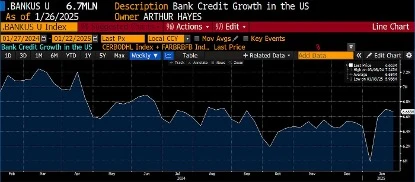
The answer is no. According to my bank credit index, which is the sum of the Federal Reserves bank reserves, deposits and liabilities, credit growth has stagnated. Money flows must remain unimpeded, and if credit expansion is slower than expected, the market will give back the gains brought by Trumps victory.
China
In the third quarter of 2023, the People’s Bank of China announced a series of measures aimed at boosting the economy. Essentially, these measures were money printing. They lowered the reserve requirement ratio for banks, began buying Chinese government bonds, and helped local governments refinance their debt. These measures ignited a fierce rebound in the A-share market.
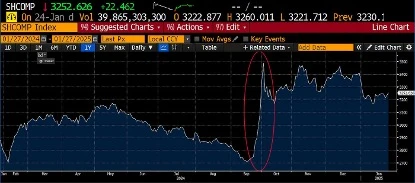
If you’re addicted to Xiaohongshu and didn’t realize when the Chinese central bank and government announced these reflationary policies, I’ve circled them on the Shanghai Composite chart above. The government wanted investors to get in first to take advantage of the asset price surges that would come with the printing of yuan, and the strategy worked.
In Lets Go Bitcoin, I argued that China was prepared to allow the renminbi to depreciate if necessary as a corollary to its massive money printing policy. The USD/CNY was allowed to rise, meaning a stronger USD and a weaker CNY. Everything went according to plan until January 2024, when China suddenly changed its policy.
On January 9, 2024, the Peoples Bank of China announced the end of its bond purchase program. The central bank intervened in the market and actively promoted the appreciation of the RMB. This means:
The central bank cannot relax the domestic financial environment by devaluing the RMB
At the same time, it took the initiative to intervene and promote the appreciation of the RMB
Economist Russell Napier believes that China is preparing for a difficult negotiation with Trump to avoid consuming policy tools in advance. He predicts that China and the United States may reach some kind of big deal because both countries want to devalue their currencies to stimulate exports and improve the domestic economy. However, leaders of both sides cannot compromise directly, otherwise they will be seen as weak by the domestic public and violate their campaign promises.
Whatever the real reason, China has chosen to stabilize the yuan rather than continue to drive economic recovery. As a result, the yuan printing press has been temporarily shut down until further notice.
Japan
The Bank of Japan (BOJ) has delivered on its promise to continue raising interest rates. At its most recent meeting, they raised the policy rate by 0.25% to 0.50%. A direct consequence of the rate normalization plan is that the expansion of the central banks balance sheet has stalled.
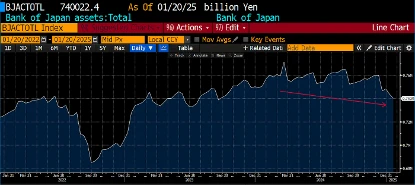
As policy rates rise, Japanese government bond (JGB) yields have climbed to levels not seen in nearly 15 years.
The money supply is growing at a much slower rate than in the past, while its price (interest rates) is rising rapidly. This is not a favorable market environment for financial assets denominated in fiat currencies.
USDJPY is in the process of topping out. I believe USDJPY will reach 100 (i.e. USD depreciates and JPY appreciates) in the next 3-5 years. As I have argued many times before, a stronger JPY will cause Japan Inc. to repatriate trillions of dollars in capital, and investors who borrowed in JPY will have to sell assets to cope with the surge in financing costs.
The biggest concern for global fiat financial markets is the negative impact of this sell-off on US Treasury prices. This will become a long-term structural headwind that Bessent must find a way to deal with. Eventually, the US government will have to solve the problem by releasing US dollar liquidity through some kind of swap line facility, but before that, the market must go through a period of pain to provide the necessary political cover to make monetary support policies reasonable.
I have already explained why fiat liquidity conditions in the USD, CNY, and JPY are unfavorable for price growth in fiat financial assets. Now, I will further explain the impact this has on Bitcoin and crypto capital markets.
The relevance of sharpening the knife
We need to discuss the biggest concerns for bond investors under Pax Americana. I will spend some time analyzing a very valuable chart produced by Bianco Research that shows the 1-year and 5-year stock-bond price correlation and draw some conclusions from it.
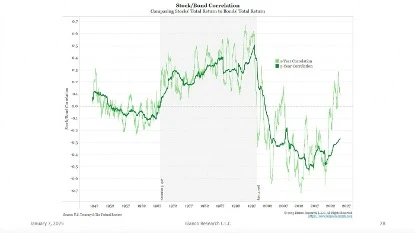
From the 1970s to the early 21st century, inflation was the boogie man that American investors feared the most. Therefore, stock and bond prices were positively correlated . When inflation increased and had a negative impact on the economy, investors would sell both bonds and stocks.
This changed after China joined the World Trade Organization (WTO) in 2001. American capitalists began to outsource manufacturing to China in exchange for increased profits for domestic companies. From then on, the focus of the market was no longer inflation, but economic growth. Under this new paradigm, falling bond prices meant faster economic growth, so stocks should perform well, resulting in a lower correlation between stocks and bonds.
However, you can clearly see that the 1-year stock-bond correlation has risen sharply since the beginning of 2021. This is because the Flu-19 crisis (fiscal stimulus during the pandemic) has caused inflation to return and soar to its highest level in 40 years. The Fed began a rate hike cycle in early 2022, during which bond prices and stock prices fell in tandem, and the relationship returned to the pattern of the 1970s to early 2000s, when inflation became the markets most important concern.
This is particularly evident in the performance of the 10-year Treasury. When the Fed pauses rate hikes in September 2023 and begins cutting rates in September 2024, inflation will still be above the 2% target, but the market will still be concerned about inflation.
The following three charts illustrate this trend:
The Federal Reserves capped federal funds rate (white) vs. the 10-year Treasury yield (yellow)
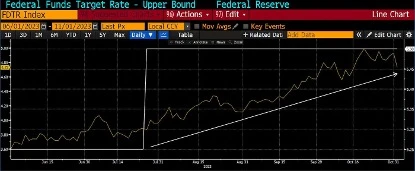
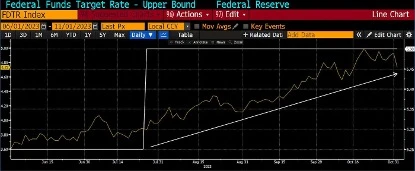
As you can see from these charts, market fears of inflation are growing as yields are rising even as the Fed is easing monetary policy (cutting rates).
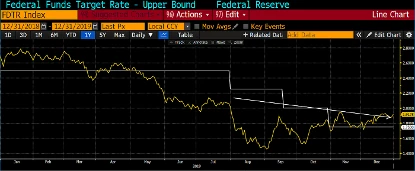
Comparing the previous two pictures, that is, the last round of interest rate cuts from the end of 2018 to March 2020, when the Fed cut interest rates, yields fell simultaneously. This time, the situation is completely different.
No matter what anyone says, the price of money will always affect assets denominated in fiat currencies. Tech stocks are extremely sensitive to interest rates, and you can think of them as a bond with an infinite maturity or duration. Simple math tells us that when the interest rate that discounts future cash flows rises, the present value of tech stocks falls. And this mathematical relationship rears its ugly head when the dysfunction of the financial system causes yields to break through a critical level.
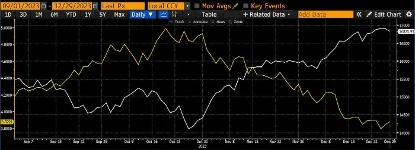
The chart above shows the Nasdaq 100 Index (white) vs. the 10-year U.S. Treasury yield (yellow). You can see that when yields approached 5%, the stock market fell, and when yields fell back, technology stocks rebounded sharply. This is a typical market reaction in a financial environment where inflation is the main concern, not economic growth.
Lets put it all together. The dollar, yuan, and yen are interchangeable in global financial markets, and they will all eventually flow into large U.S. technology stocks in some form. Whether you like it or not, this is true. I have just analyzed why in the short term, the United States, China, and Japan are not accelerating the expansion of fiat money supply, and in some cases are even raising the price of money.
Inflation remains high and, against the backdrop of a global economic decoupling, is likely to rise further in the near term. That is why I expect the 10-year Treasury yield to continue to rise. So how do stock markets react when the reason for the rise in yields is the markets fear of inflation and the rapid expansion of the US debt with no new marginal buyers? They will plunge.
In the long term, Bitcoin is not highly correlated with the stock market, but in the short term, their correlation could become very high. Bitcoins 30-day correlation with the Nasdaq 100 is high and continues to rise. If technology stocks suffer a setback due to a surge in 10-year Treasury yields, this would not bode well for Bitcoins short-term price action.
Furthermore, I firmly believe that Bitcoin is the only truly free market in the world and is extremely sensitive to changes in global fiat liquidity. Therefore, if a fiat liquidity crunch is imminent, the price of Bitcoin will crash before the stock market and become a leading indicator of financial stress.
If panic selling in the bond market leads to systemic stress in financial markets, the regulator’s answer will be to print money. First, the Fed will side with Trump and do its “patriotic duty” – press the button on the USD Brrr. Then, the PBOC can also relax monetary policy in sync without worrying about the depreciation of the RMB. Remember, the monetary system is relative, and if the Fed prints money on a large scale, then the PBOC can print money in sync without affecting the USD/RMB exchange rate.
As for Japan, the largest foreign exchange asset holdings of Japan Inc. are U.S. dollar-denominated financial assets. Therefore, if the prices of these assets fall, the Bank of Japan (BOJ) will pause its rate hikes to ease the financial environment for the yen.
In short, a mini-financial crisis in the United States would provide the cryptocurrency market with the monetary nectar it so desperately desires. It would also be extremely beneficial to Trump’s political interests. All things considered, I would rate this scenario as having a 60% chance of happening in the first or early second quarter.
Trading Probability and Expected Value
As mentioned in the introduction, when we sensed an increase in avalanche risk, we stopped skiing. The point is, dont risk your life to verify the unknown danger. Extending this metaphor to the crypto market, Maelstrom chose to keep an underweight position in the market to hedge the risk. The core here is not right or wrong, but expected value (EV).
How do you know you’re wrong? You never really know, but in my opinion, if Bitcoin breaks $110,000 (the high during the $TRUMP mania) on strong volume and perp open interest rises sharply, then I’ll throw in the towel and cover my position at higher levels.
More specifically, $TRUMP’s 24-hour rally to nearly $100 billion in fully diluted valuation (FDV) was an absolutely ridiculous market signal. I bought it a few hours after it went live and sold it halfway through my weekend spa vacation. I made many times more money on this trade than the entire vacation cost, all with a few clicks on my phone. Trading shouldn’t be that easy, but during the mania, it was.
In my opinion, the $TRUMP surge signal is similar to FTXs purchase of the MLB umpire advertising logo during the 2021 bull run - it symbolizes that the market top is approaching.
The core of trading is not right or wrong, but the perception of probability and the maximization of expected returns. Let me explain my thinking logic. Of course, these probabilities are subjectively perceived, and the essence of investment is to make decisions under imperfect information.
Why I think Bitcoin will have a 30% pullback
I have been trading in this market for over 10 years and have experienced three bull markets. This magnitude of pullback is very common in bull markets. More importantly, after Trumps reelection in early November 2024, Bitcoin quickly broke through the all-time high set in March. Many people, including me, have widely discussed that Trumpism will accelerate the printing of money in the United States, and other countries will also respond by printing money to stimulate their economies.
But the core point of this article is that these large-scale monetary easing policies in the United States, China and Japan cannot be launched before a real financial crisis occurs.
Therefore, I think the market will retrace to its previous all-time high, completely erasing the Trump bump.
Trading strategy calculation:
60% probability: Bitcoin will retrace by 30%
40% probability: bull market continues, Bitcoin rises 10%
Calculate the expected return (EV):
(60% * -30%) + (40% * 10%) = -14%
Math tells me that reducing risk is the right choice. I reduce risk by selling Bitcoin and holding more liquid assets (staking USDe, current annual yield of 10% ~ 20%).
If Bitcoin drops 30%, the altcoin market will be devastated. And this is where I am really interested.
Maelstrom holds a large number of liquid altcoin positions obtained from early investments and advisor allocations. We have already liquidated most of them. The highest quality projects on the market will plummet by at least 50% if Bitcoin falls by 30%.
The eventual mega liquidation candle will tell me when to “buy the dip” and buy the crypto dung in the market.
If I’m wrong, my loss is just taking profits early and selling some of the Bitcoin I bought with my altcoin profits. But if I’m right, we have plenty of cash on hand to quickly add to our positions in a market sell-off and make 2x or even 3x profits on quality altcoins.
Conclusion
When this article was submitted to my editor on Monday, January 27, 2025, the market was in a full-blown panic as investors began to reevaluate their bullish logic on NVIDIA and US technology stocks, and the trigger for all this was the release of DeepSeek, an AI model developed by a Chinese team that costs 95% less to train than the latest models from OpenAI and Anthropic, but outperforms them.
The nature of bubbles is that when investors begin to question one core belief, they begin to question all beliefs. What I am most concerned about is the collapse of the markets belief that interest rates dont matter. The DeepSeek incident may prompt Western investors to panic across the board and start paying attention to the global fiat currency liquidity crisis and the long-term upward trend of the 10-year US Treasury yield.
Its really ironic that China is embracing open-source while the US is still clinging to walled gardens. Market competition is a wonderful thing, isnt it?









